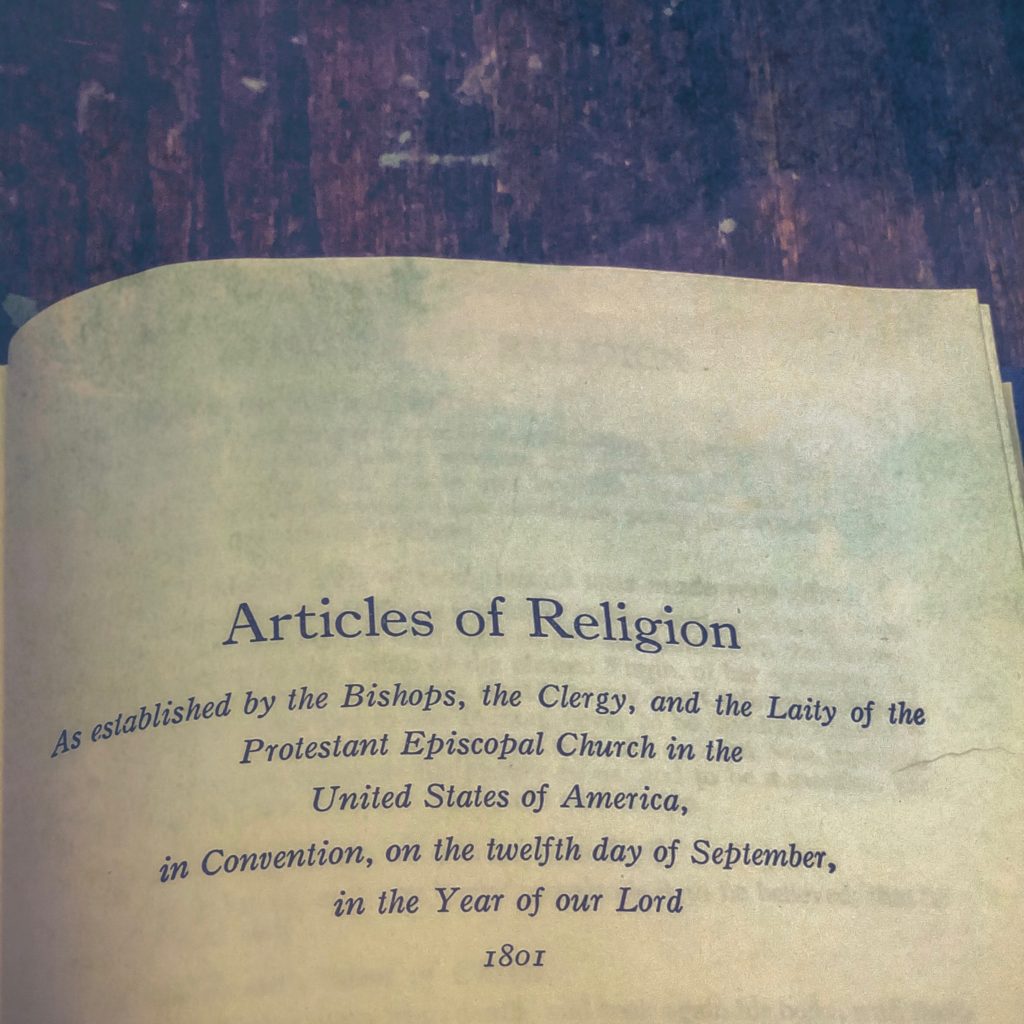
The Cup of the Lord is not to be denied to the Lay-people: for both the parts of the Lord’s Sacrament, by Christ’s ordinance and commandment, ought to be ministered to all Christian men alike.
by the Rev. Elizabeth Hadaway
Added in the revisions of 1563-1571, Article 30 counters a clericalist practice gradually developed and recently (in 1415) codified in Roman Catholicism, where only the presider drank. It is no requirement for all communicants to receive in both kinds, as pastoral rubrics elsewhere in the Book of Common Prayer show. Rather, Article 30 emphasizes that Bishops, Priests, and Deacons are orders within, not above, the community of the baptized.
The Western church’s removal of the cup from the laity had met resistance, famously from Jacob of Mies and Jan Hus. “In response to Bohemian utraquists who insisted on the right of the laity to receive the chalice, the Council of Constance in 1415 declared communion sub una [in one kind] to be the law of the church….No such development took place in Eastern Christianity” (Huels 240).
Later reformers were well aware that the Council of Constance had also executed Hus. This did not stop them from following his example of looking to scripture and church history for guidance.
Scriptural warrants for communion in both kinds include Matthew 26.26-30, Mark 14.22-25, Luke 22.17-20 and 1 Corinthians 11. Of these passages, Martin Luther, in The Babylonian Captivity of the Church, says “as Matthew, Mark, and Luke all agree, Christ gave all His disciples both kinds. And that Paul gave both kinds is so certain that no one has had the effrontery to say anything to the contrary. A further fact is that, according to Matthew, Christ did not say of the bread, ‘All of you eat of this’; but He does say of the cup: ‘All of you drink of this’; and in Mark He does not say: ‘All of you ate’, but ‘All of you drank from it’. Each writer attaches the mark of universality to the cup, but not to the bread. It is as if the Spirit foresaw the coming division forbidding the communion of the cup to some, though Christ would have had it common to all” (257-258).
“All” means all disciples of Christ, “all Christian men alike,” in the Article’s words and with both Luther’s and the Article’s assumption that all persons in attendance have already been baptized. Article 30 is definitely not an argument for attempting “communion without baptism.” Instead, reception in both kinds follows from baptism.
“Just as the rites of baptism and absolution are administered to the laity in their full form,” Luther says, “so also should the complete sacrament of the Supper, if asked for,” be administered (259). Turning from Scripture to the history of the church in North Africa, Luther cites St. Cyprian, who “testifies that it was the custom in the church at Carthage to give both kinds to many of the laity, even children; and he provides many examples” (262-263). Cyprian’s examples, quoted by Luther, include a young girl.
Anticipating an attack on the practice of administering in both kinds as undisciplined, Luther points out that the church at Carthage did require those receiving to be prepared, quoting Cyprian’s On The Lapsed, book V: “The sacrilegious man is wrath with the priests when he is not forthwith given the body of the Lord thought his hands are unwashed, or allowed to drink the blood of the Lord though with unclean lips” (263).
By praising Cyprian as a teacher martyred for refusing to follow the rites of the pagan Roman state, Luther connects Jan Hus to the ancient tradition of martyrdom for the Gospel.
Thomas Cranmer will make that connection in his own death and in his life. In A Defence of the True and Catholic Doctrine of the Sacrament of the Body and Blood of Our Saviour Christ, with a Confutation of Sundry Errors Concerning the Same, Grounded and Stablished upon God’s Holy Word, and Approved by the Consent of the Most Ancient Doctors of the Church, Cranmer cites Justin Martyr as “the oldest author that this day is known to write any treaty upon the sacraments” (88). Finding the earliest doctrinal source matters intensely to the reformers, and what Cranmer finds here is communion in both kinds for those who dare to be publicly committed followers of Jesus.
Cranmer reports his discovery like long-hidden treasure, saying that Justin Martyr: “writeth in his second Apology, ‘That the bread, water, and wine in this sacrament are not to be taken as other common meats and drinks be, but that they be meats ordained purposely to give thanks to God, and therefore be called Eucharistia, and be called also the body and blood of Christ. And that it is lawful for none to eat or drink of them, but that profess Christ, and live according to the same” (Cranmer 88-89).
Under capitalism, later readers might be tempted to think of “profession” only as “a job that makes money.” So it matters very much that we distinguish between the world’s vocabulary and the church’s terms. We also need to do this with the Article’s term “Lay-people.” The secular world often uses the word “laypeople” to mean the unprofessional, or unqualified. Such terms have developed from “professionals”—doctors or lawyers, for example—considering themselves to have achieved a kind of priesthood. However, when it comes to Communion, all baptized persons are to profess Christ crucified. Baptism itself is a public profession of following Jesus, for an eternal living.
Ordination does not make anyone a better follower of Jesus. As Justin Lewis-Anthony writes, suggesting a set of boundaries for priests to make clear to their parishioners, “I am not a ‘professional’ Christian; I am an amateur at this. I am doing it, not for money, nor status, nor power, but for the love of it (for the love of him). Don’t think that I can carry your need for holiness as well as my own. Let’s carry them together” (187).
In both elements of communion, Cranmer has already sensed this carrying together. From the “great number of grains” joined together to make one loaf, and the many grapes pressed together to make wine, “likewise is the whole multitude of true Christian people spiritually joined, first to Christ, and then among themselves together, in one faith, one baptism, one holy spirit, one knot and bond of love” (Cranmer 72).
Cranmer’s analogy appeals to the senses. In The Laws of Ecclesiastical Polity, Richard Hooker develops that aesthetic appeal as a more detailed argument for reception in both kinds. “Wisdom to the end she might save many built her house of that nature which is common to us all,” Hooker says (224). These are common elements—the house wine, our daily bread—and yet they carry the holiness of Jesus Christ.
We hope to grow toward Christ in holiness, and the very fact that receiving in both kinds takes time and repetition (and occasional messiness) is a reminder that growth takes time and repetition (and occasional messiness). As Hooker puts it, “We receive Christ Jesus in Baptism once as the first beginner, in the Eucharist often as being by continual degrees the finisher of our life” (259). Receiving in both kinds offers an example of “continual degrees” even during the wait between the bread and the cup; it is a counsel to patience with ourselves and others as we move from glory to glory.
Such brilliant polishing is a continual process. “The grace which we have by the holy Eucharist doth not begin but continue life. No man therefore receiveth this sacrament before Baptism, because no dead thing is capable of nourishment” (Hooker 348). Sacramental life begins at baptism, but it does not end there. Hooker takes infant baptism as a given, but even as adults we can be spiritual infants. Always we are called to a greater perception of how God nourishes us for the journey towards holiness. “Whereas therefore in our infancy we are incorporated into Christ and by Baptism receive the grace of his Spirit without any sense or feeling of the gift which God bestoweth, in the Eucharist we so receive the gift of God, that we know by grace what the grace is which God giveth us” (Hooker 348). This knowledge comes through our senses. It is not merely a symbol; it is embodied in the “gifts and creatures of bread and wine” (Book of Common Prayer 335). Through them, as with the disciples at Emmaus who met Jesus on the road—and with Hus and Cranmer, burned at the stake—our hearts gradually catch fire.
Elizabeth Hadaway (@e_hadaway) is Priest Associate at St. Andrew’s Episcopal Church in Buffalo, New York. As Leigh Palmer, she held a Wallace Stegner Fellowship at Stanford. Her book Fire Baton (University of Arkansas Press) won the 2007 Library of Virginia prize in poetry; The Journal of Inklings Studies (8.1) features her commentary with Rowan Williams and Malcolm Guite on Joy Davidman’s sonnets, and her chapter “Poet, Priest, and ‘Poor White Trash'” concludes Appalachian Reckoning: A Region Responds to Hillbilly Elegy (West Virginia University Press, 2019).
Works Cited
Book of Common Prayer. New York: Church Publishing, 1979.
Cranmer, Thomas. A Defence of the True and Catholic Doctrine of the Sacrament of the Body and Blood of Our Saviour Christ, with a Confutation of Sundry Errors Concerning the Same, Grounded and Stablished upon God’s Holy Word, and Approved by the Consent of the Most Ancient Doctors of the Church. In The Work of Thomas Cranmer. Ed. G.E. Duffield. Philadelphia: Fortress, 1965.
Hooker, Richard. Of The Laws of Ecclesiastical Polity. Book V, Vol. 2. Collected by John Keble.
Ellicott City, Maryland: Via Media, 1994.
Huels, John M. The New Dictionary of Sacramental Worship. Collegeville, Minnesota: The Liturgical Press, 1990.
Lewis-Anthony, Justin. If You Meet George Herbert on the Road, Kill Him: Radically Re-thinking Priestly Ministry. New York: Mowbray, 2012.
Luther, Martin. Selections From His Writings. Trans. Bertram Lee Woolf. New York: Anchor, 1961.
